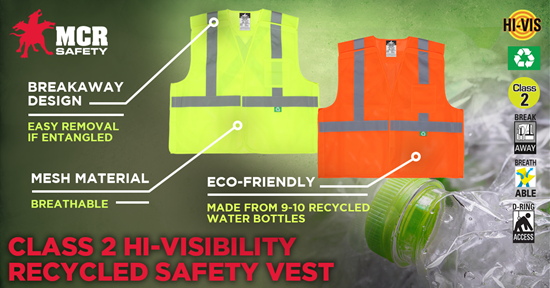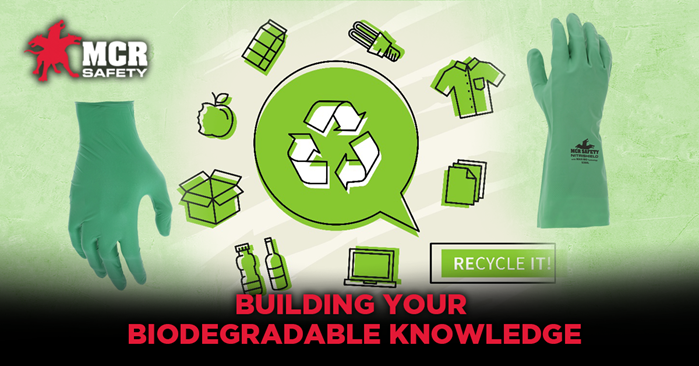22 May 05/22/2021
Building Your Biodegradable Knowledge
There's a lot of attention given lately to creating environmentally-friendly products and processes — and with good reason. It's estimated that Americans generate 254 million tons of waste each year, equating to around 4.4 pounds of trash per person in the U.S. If packed into cubic feet, this would be equal to the height of the Leaning Tower of Pisa. Some of this waste will decompose, but much of it will last thousands of years in the landfill. Glass, for example, can even last for millions of years. But it's not just the sheer mass of waste that can be harmful to the environment. Decomposing waste in landfills produces toxic methane gases 100-120 times more potent than carbon dioxide, making it essential to reduce decomposing waste.
As the PBS NewsHour reported on 4/22/2021, personal protective equipment (PPE) has become a term known by virtually everyone, as its use has been vital in keeping people protected during the COVID-19 pandemic. However, the same single-use PPE that protects us has been piling up in landfills, creating an even more significant plastic problem than what already existed pre-COVID. During the pandemic, millions of disposable gloves and masks have been worn to fight germs and infection. And, unfortunately, the majority of PPE purchased during the pandemic doesn't quickly degrade, impacting wildlife and our water.
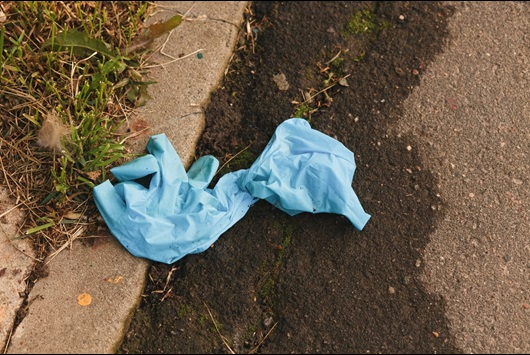
There has been a lot of PPE waste and pollution caused from the coronavirus pandemic.
But don't worry, this problem is not being ignored. There are now new alternatives for disposable PPE! As you'll learn in our Biodegradable Gloves article, MCR Safety is introducing new biodegradable glove options to help combat the problem of PPE waste. However, while widely used, the term "biodegradable" is misunderstood by many. It is essential to understand what it means for products to be biodegradable and understand how to best dispose of them. Although they are often used interchangeably, recyclable, biodegradable, and compostable do not mean the same thing and are not "close enough" to one another to figure they're all equally safe for the environment.
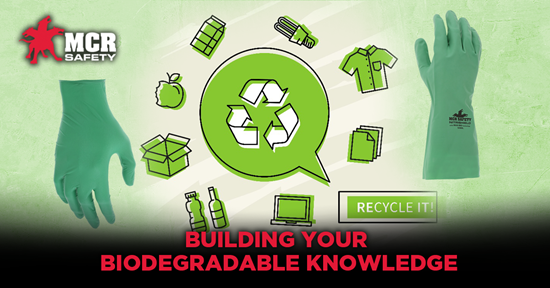
This article is designed to increase awareness of what it means for a product to be biodegradable, discuss what makes materials biodegradable, and answer some common questions about biodegradable products.
Recyclable vs. Biodegradable vs. Compostable
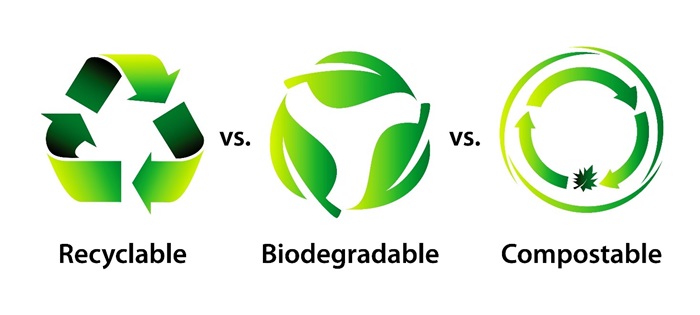
Recyclable
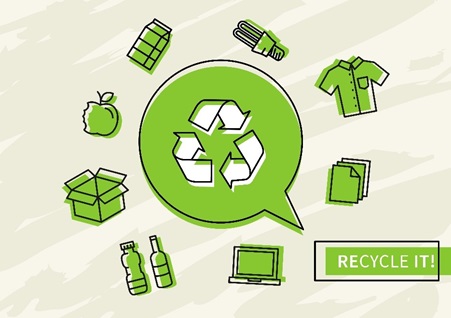
Recycling involves using waste materials to produce new objects. One example of such a product is our recycled safety vests made from the plastic of 10 recycled water bottles.
MCR Safety continues to look for ways to reduce, reuse, and recycle materials to minimize our carbon footprint and positively impact the environment. In addition to our safety vests featuring recycled material, our manufacturing facilities also recycle leftover materials from the fashion industry and repurpose them to manufacture cotton string knit gloves. You can learn more about this environmentally-friendly manufacturing process in our Cotton Gloves article.
Biodegradable
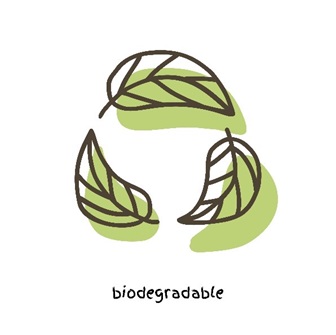
What does biodegradable mean? When dumped into landfills with no air source, Biodegradable items break down into natural elements when exposed to oxygen and beneficial bacteria. While most waste material will eventually degrade over time, materials considered biodegradable break down much faster and dissolve into environmentally safe organic material.
Compostable
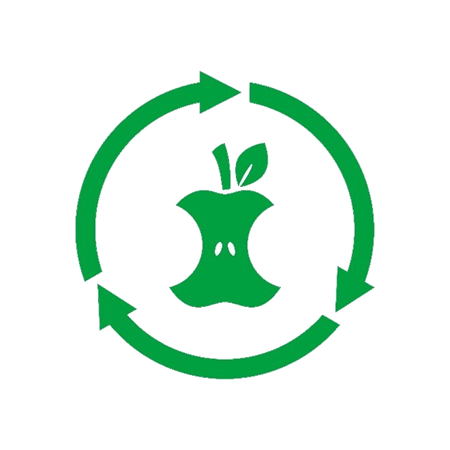
Compostable products break down into natural elements in a compost setting, which is just a collection of organic waste and food scraps. This breakdown can happen in as little as 90 days, forming a nutrient-rich by-product good for curating healthy soil. Compost heaps break these items down very fast due to high temperatures and rich microorganism diversity.
Biodegradable Definition and Meaning
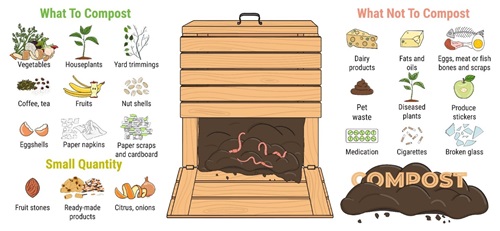
Items that are biodegradable disintegrate or decompose naturally via the work of microorganisms like bacteria or fungi, UV light, water, and oxygen. These actions are biological and allow a product to assimilate into the natural environment around it without leaving toxins behind. To put it more simply, Science Direct defines biodegradability as "biological degradation of organic materials by living organisms down to the base substance."
For an item or material to be considered biodegradable, it has to quickly decompose into harmless materials, reduce the buildup of harmful waste, and contribute to a safer and cleaner environment. According to WebstaurantStore, the decomposition of most food and restaurant waste occurs between 6 and 9 months, for example.

You Matter explains that when a material biodegrades, it does not harm the environment in the process. Biodegradable materials may include either solids, which are compostable, or liquids that degrade into water. To achieve biodegradability, products are made from sustainable materials — often plant by-products like cornstarch or sugar cane — and they mix seamlessly with the earth as they break down, leaving nothing negative behind.
What is left after biodegradable substances decompose? Products that are biodegradable break down into organic elements that living organisms can use. Examples include the following:
- Carbon dioxide
- Nitrogen
- Water
- Inorganic salts
- Gases
Theoretically speaking, almost all products are biodegradable, but some break down faster and are safer for the environment as they do so than others. A material's biodegradability boils down to the environmental conditions surrounding the material itself. Vegetables can biodegrade within months; however, some stay on the plant for a long time. Our next image will give you an idea of how long some items remain on earth.
Non-Biodegradable
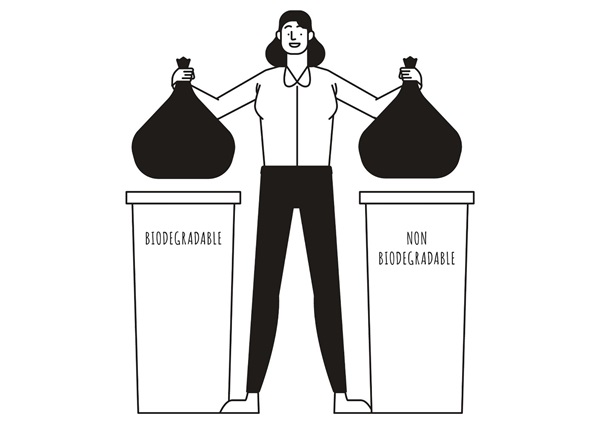
Understanding what makes something non-biodegradable is advantageous for all consumers, including environmentally-conscious individuals. Merriam Webster defines non-biodegradable products as those that are "not capable of being broken down by the action of living organisms." These products, unfortunately, act as a significant catalyst for pollution and illnesses such as cancer. Examples of non-biodegradable materials include metallic cans, pesticides, polystyrene, and paints.
Non-biodegradable waste cannot be decomposed or dissolved through natural agents, as it is often too challenging for microorganisms to break down. And, even when some biodegradation occurs, the result may be more harmful to the environment in its new form.
Is plastic a biodegradable product?
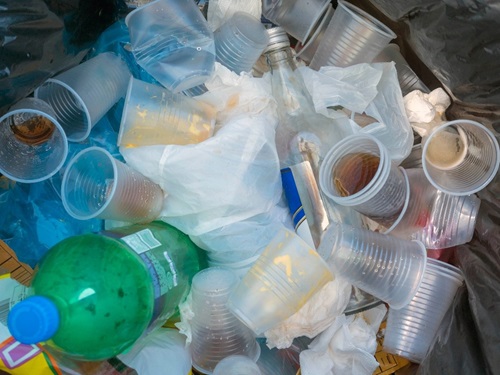
The short answer to this question is: "It depends." Plastics can take hundreds of years to break down independently, and some can even remain in the environment for thousands of years. Most plastics don't biodegrade significantly in any environmental condition, making the material a critical threat to our planet. And, sometimes, what little breakdown does occur forms chemicals, toxic gases, and tiny microplastics that cause all kinds of issues in our soil, waterways, oceans, and drinking water.
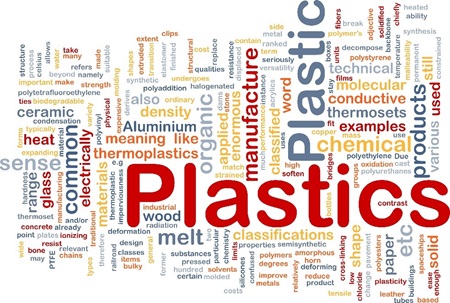
Some biodegradable plastics, such as food service containers, are made from renewable raw materials, microorganisms, petrochemicals, or some combination of these.
There are two main types of biodegradable plastics used to make these products:
- Oxo-Biodegradable Plastic (OBP) – adds certain compounds of transition metals to conventional plastics
- Hydro-Biodegradable Plastic (HBP) – created from bio-based resources such as corn, wheat, and sugar cane
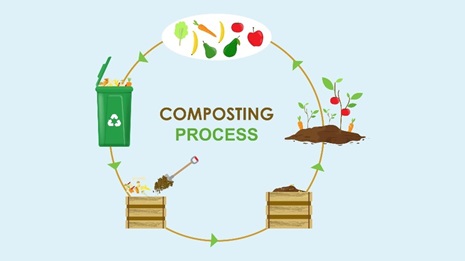
Both OBPs and HBPs are compostable, but only oxo-biodegradable polymers can be recycled.
The main drawback to biodegradable plastics is that they must be processed at well-managed industrial composting facilities that produce high amounts of UV light and regulate temperatures to accelerate biodegradation. Without such an environment, these products are not genuinely biodegradable and will break down much more slowly. Other plastics may be labeled as biodegradable but only break down into smaller microplastics that continue to pose environmental hazards.
Plastic Lifespan
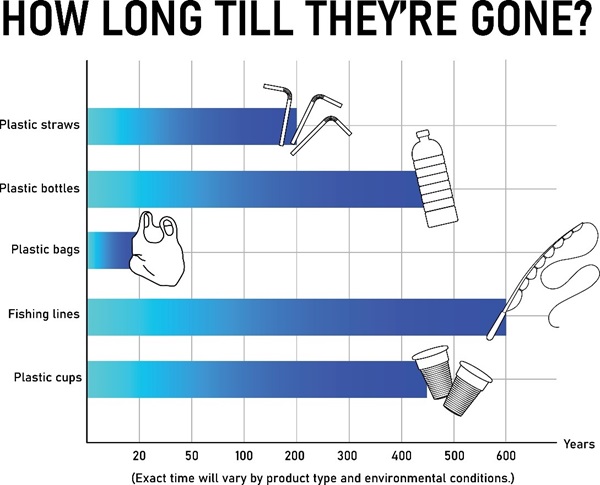
To give you an idea of how long 600 years is, which is how long fishing line takes to biodegrade, consider this: 600 years ago, Joan of Arc had not been born, Constantinople was still around, and the printing press had not been invented yet. Think about that the next time you toss some plastic into nature.
Materials that don't break down quickly and efficiently are often referred to as non-biodegradable. Some of these materials can be recycled. The following section discusses non-biodegradable products, including plastics.
Materials and Polymers
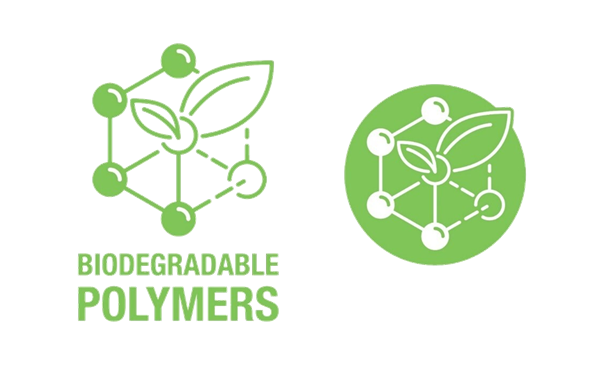
What makes a material biodegradable? The first biodegradable plastics and polymers were introduced to the world in the 1980s.
Biodegradable polymers typically consist of ester, amide, or ether bonds that can be categorized into two groups centered on their structure and synthesis:
- Agro-polymers – derived from biomass, including starches and animal-based proteins
- Bio-polyesters – derived from microorganisms or made from natural or synthetic monomers
Biodegradable polymers have a wide range of applications, but they all must be stable, durable, and break down quickly. Our next section will highlight the numerous products utilizing biodegradable polymers.
Products
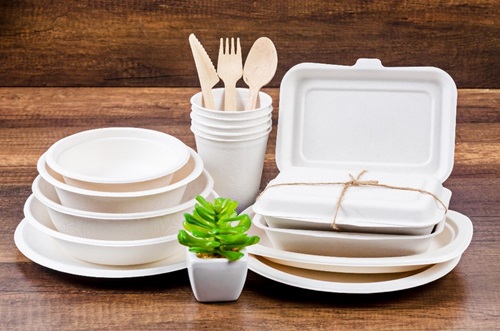
There has been an explosion of biodegradable products in the past decade, with no end in sight. Many businesses are making it a priority to design more eco-friendly packaging, such as biodegradable packing peanuts. This improved and cheaper inner packaging replaces Styrofoam, which is neither biodegradable nor recyclable.
Here are some other products seeing biodegradability improvements:
- Bags - Inwaysin trash bags made from plants
- Cups - Planet+ petroleum-free drinking cups
- Diapers - Eco Boom plant-based, 100% biodegradable top-sheet, and back-sheet
- Shoes - SeaVee made with biodegradable wool and no metal components
- Straws - The Veggie Straws made from veggie fibers
And now, there are even PPE products that easily return to Mother Earth with little negative impact.
Biodegradable Gloves
Click the above image to learn more about the latest biodegradable products introduced by MCR Safety.
Common Questions

What makes something biodegradable?
- Biodegradable products can break down over time into more minor, harmless organic compounds like carbon dioxide, water, and oxygen.
Is rubber biodegradable?
- Rubber is biodegradable, but it is a slow process. Engineers can incorporate additives to slow or speed up the progression of rubber as a biodegradable product.
What are the problems with biodegradable plastics?
Biodegradable plastics must decompose in industrial composting facilities. If they end up in the mainstream of waste, they can break down in the soil or waterways or break apart into microplastics harmful to fish and other living organisms.
Is PLA biodegradable?
- Materials like polylactic (PLA) plastics are made from corn, beets, cassava, or sugar cane instead of petroleum, but they must be sent to commercial composting facilities to degrade properly. Corn plastic is biodegradable if sent to a controlled composting environment, where the material reaches a temperature of 140°F for ten consecutive days. During that time, scraps are digested by microfibers. Due to limited infrastructure to carry out the above operation, many still see this solution as non-biodegradable.
Is nylon biodegradable?
- Nylon is not a biodegradable material and causes a significant impact on the world's ecosystems.
Is glass biodegradable?
- It can take up to 1 million years for glass to decompose, which is evident by numerous ancient Egyptian artifacts still with us today.
Is Styrofoam biodegradable?
- Styrofoam, the trade name for foamed polystyrene, breaks down at a minimal pace. The Environmental Action Association estimates that the material will still be here 500 years from now.
Is silicone biodegradable?
- Silicone is a human-made fiber made from silicon (readily found in most sand), oxygen, and other elements like carbon and hydrogen. While it is not naturally biodegradable, it is far sturdier and more durable than plastics, even at high temperatures. It can be recycled in unique recycling plants. It will not break down in a landfill, but it also will not biodegrade or decompose into harmful microplastics that pollute our waterways.
Is cardboard biodegradable?
- When not contaminated by food, water, or oils, cardboard is recyclable. But is it biodegradable? Cardboard is made from natural elements. It can contribute to deforestation, but it's also compostable; it can break down into natural pieces without leaving any harmful toxins, making it biodegradable. The presence of heat and moisture helps cardboard biodegrade more quickly, and it can biodegrade underground in as little as two months, though it may take longer if it is covered in wax.
Is cotton biodegradable?
- Cotton degrades 76% after 243 days and will continue the degradation process over time.
Is polyester biodegradable?
- In the study shown in the cotton link above, polyester only degrades by about 4% after 243 days. In its entirety, polyester can take 20 to 40 years to biodegrade.
MCR Safety: Protecting the Planet and People
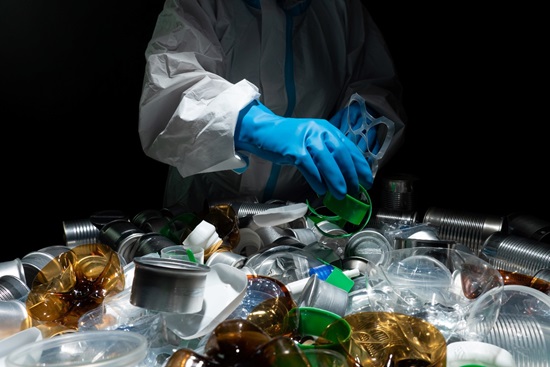
Are you feeling guilty about using countless disposable gloves every day? Gloves that will take decades to decompose? Don't worry, we're on top of it! Our specialty is protecting people. However, our planet is going through some dynamic changes in the 21st century, especially as the world population approaches 9 billion people occupying it. At MCR Safety, we're constantly engaged in research and development to make improvements in the products we sell, ensuring we all have a protected home for centuries to come!
We welcome any comments, feedback, or suggestions for how we can best protect people at work.
For over 45 years, MCR Safety has proven to be a world leader in gloves, glasses, and garments. Whether it's on the shop floor, an oil rig, or a construction site, we are there to provide solutions to workplace hazards. It's all part of our commitment to protect people.
No matter your industry, we have the personal protective equipment you need.

Learn more about MCR Safety by checking out our most recent video. For more information, browse our website, request a catalog, find a distributor, or give us a call at 800-955-6887.
About the Author
Related Articles
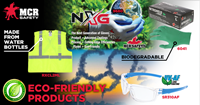
MCR Safety's Best Eco-Friendly PPE Products
MCR Safety offers a variety of PPE products that are made with eco-friendly materials. To be...
Explaining Green, Eco-Friendly, and Environmentally Friendly
The term "eco-friendly" gets used a lot and is applied to many different products and items....Latest Articles





